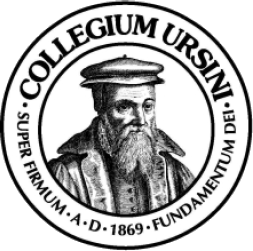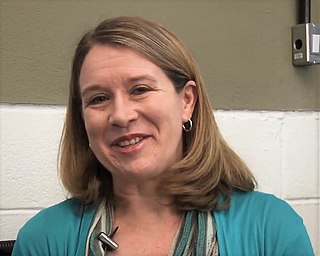
Ursinus College is a private liberal arts college in Collegeville, Pennsylvania. It was founded in 1869 and occupies a 170-acre campus. Ursinus College's forerunner was the Freeland Seminary founded in 1848. Its $127 million endowment helps support about 1500 students. Students choose from 60 courses of study.
Angela K. Wilson is an American scientist and former (2022) President of the American Chemical Society. She currently serves as the John A. Hannah Distinguished Professor of Chemistry, associate dean for strategic initiatives in the College of Natural Sciences, and director of the MSU Center for Quantum Computing, Science, and Engineering (MSU-Q) at Michigan State University.
Cynthia Larive is an American scientist and academic administrator serving as the chancellor of University of California, Santa Cruz. Larive's research focuses on nuclear magnetic resonance spectroscopy (NMR) and mass spectrometry. She was previously a professor of chemistry and provost and executive vice chancellor at the University of California, Riverside. She is a fellow of AAAS, IUPAC and ACS, associate editor for the ACS journal Analytical Chemistry and editor of the Analytical Sciences Digital Library.

Margaret Mary Sheil is an Australian academic and the Vice Chancellor and President of Queensland University of Technology.

Sheila Rowan is a Scottish physicist and academic, who is Professor of Physics and Astronomy at the University of Glasgow in Scotland, and director of its Institute for Gravitational Research since 2009. She is known for her work in advancing the detection of gravitation waves. In 2016, Rowan was appointed the (part-time) Chief Scientific Advisor to the Scottish Government.
Manijeh Razeghi is an Iranian-American scientist in the fields of semiconductors and optoelectronic devices. She is a pioneer in modern epitaxial techniques for semiconductors such as low pressure metalorganic chemical vapor deposition (MOCVD), vapor phase epitaxy (VPE), molecular beam epitaxy (MBE), GasMBE, and MOMBE. These techniques have enabled the development of semiconductor devices and quantum structures with higher composition consistency and reliability, leading to major advancement in InP and GaAs based quantum photonics and electronic devices, which were at the core of the late 20th century optical fiber telecommunications and early information technology.

Christy Lynn Haynes is a chemist at the University of Minnesota. She works at the interface of analytical, biological, and nanomaterials chemistry.

Raychelle Burks is an associate professor of analytical chemistry at American University in Washington, D.C., and science communicator, who has regularly appeared on the Science Channel. In 2020, the American Chemical Society awarded her the Grady-Stack award for her public engagement excellence.
Kimberly A. Prather is an American atmospheric chemist. She is a distinguished chair in atmospheric chemistry and a distinguished professor at the Scripps Institution of Oceanography and department of chemistry and biochemistry at UC San Diego. Her work focuses on how humans are influencing the atmosphere and climate. In 2019, she was elected a member of the National Academy of Engineering for technologies that transformed understanding of aerosols and their impacts on air quality, climate, and human health. In 2020, she was elected as a member of the National Academy of Sciences. She is also an elected Fellow of the American Philosophical Society, American Geophysical Union, the American Association for the Advancement of Science, American Philosophical Society, and the American Academy of Arts and Sciences.
Shelley D. Minteer is an American academic and chemistry professor at the University of Utah. Minteer field of study focuses on the interface between biocatalysts and enzyme-based electrodes for biofuel cells and sensors.
Peter Kenneth Dorhout is a professor of chemistry and the Vice President for Research at the Kansas State University. He was the 2018 President of the American Chemical Society (ACS). As an advocate for science, he has had the opportunity to talk to United States congressional staff about the importance of basic science funding through the National Science Foundation.
Jannick Rolland is the Brian J. Thompson Professor of Optical Engineering at the Institute of Optics at the University of Rochester. She is also the co-founder and CTO of LighTopTech, a women-owner business founded in 2013 to create medical imaging technologies with biomimetic noninvasive imaging technology. At the University of Rochester, she is the Director of the NSF I/UCRC Center for Freeform Optics (CeFO). She is also the Director of the R.E. Hopkins Center for Optical Design and Engineering that engages undergraduates in optical design, fabrication, and metrology.

Jennifer (Jen) Dionne is an American scientist and pioneer of nanophotonics. She is currently Senior Associate Vice Provost of Research Platforms at Stanford University, a Chan Zuckerberg Biohub Investigator, and an Associate Professor of Materials Science and Engineering and by courtesy, of Radiology. She serves as Director of the Department of Energy's "Photonics at Thermodynamic Limits" Energy Frontier Research Center (EFRC), which strives to create thermodynamic engines driven by light, and she leads the "Extreme Scale Characterization" efforts of the DOE's Q-NEXT Quantum Science Center. She is also an Associate Editor of the ACS journal Nano Letters. Jen's research develops optical methods to observe and control chemical and biological processes as they unfold with nanometer scale resolution, emphasizing critical challenges in global health and sustainability.

Isiah Manuel Warner is the Boyd and Phillip W. West Professor of Surface and Analytical Chemistry and the Vice President for Strategic Initiatives at Louisiana State University. He’s also a professor at the Howard Hughes Medical Institute. Warner has won numerous national and international awards for chemistry and mentoring of students in the sciences. He has published over 350 refereed publications and has several patents.
Susan Davis Allen is an American engineering professor and academic administrator. She is currently Associate Dean of Research for the College of Engineering and Distinguished Professor of Mechanical Engineering at Embry-Riddle Aeronautical University. Her research has spanned multiple applications of lasers and optics, including spectroscopy, laser sensors, laser ablation, micromachining, and others.
Carmen S. Menoni is an Argentine-American physicist who is the University Distinguished Professor at Colorado State University. Her research considers oxide materials for interference coatings and spectrometry imaging. She is a Fellow of the Institute of Electrical and Electronics Engineers, American Physical Society, The Optical Society and SPIE. Menoni served as the President of the IEEE Photonics Society from 2020 to 2021.
Linda Ellen Jones is an academic in the field of chemical engineering, and known for her work in high temperature chemistry. She is a professor at Western New England University and an elected fellow of the American Ceramic Society.
Catherine E. Costello is the William Fairfield Warren distinguished professor in the department of biochemistry, Cell Biology and Genomics, and the director of the Center for Biomedical Mass Spectrometry at the Boston University School of Medicine.
Karen H. Johannesson is an American geochemist and professor in the School for the Environment at the University of Massachusetts Boston and the Intercampus Marine Sciences Graduate Program of the University of Massachusetts System. She teaches geochemistry and has expertise in environmental geochemistry, biogeochemistry, trace element speciation, geochemical modeling, chemical hydrogeology, reaction path and reactive transport modeling.
Hilkka Inkeri Kenttämaa is a researcher in organic and bioorganic mass spectrometry, and the Frank Brown Endowed Distinguished Professor of Chemistry at Purdue University. She is a pioneer in distonic radical cation research and laser-induced acoustic desorption.







